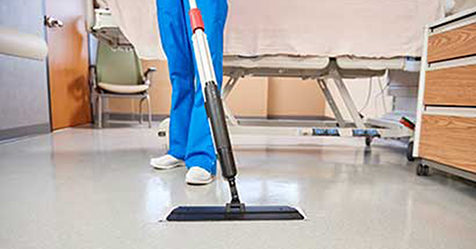Infection prevention tools have come a long way from the days of the string mop and bucket. Increased awareness of the harmful bacteria that can be found on floors—and its potential to spread to other high-touch areas—requires facility managers to use tools that not only clean and disinfect, but also prevent the spread of bacteria through cross contamination. With the rising costs of health care-associated infections (HAIs), infection prevention practices in hospitals are crucial in keeping costs down and patients healthy. Two infection prevention innovations in particular are helping facility managers clean and disinfect with more efficacy than ever before: disposable mop pads and chemical accuracy systems.
Compare washable vs. disposable mop pads
When picking a mop pad, facility managers have a choice between washable and disposable pads. Washable mop pads have been around longer; facilities launder them for repeated use. However, these pads can still spread germs if they are not washed properly. To ensure disinfection, the U.S. Centers for Disease Control and Prevention (CDC) recommends washing them at a temperature of at least 160 degrees Fahrenheit for a minimum of 25 minutes, then drying them at 140 degrees Fahrenheit.
These washable mop pads can be time-consuming for staff to keep clean. Another disadvantage is frequent washings physically deteriorate the cleaning ability of the mop, reducing cleaning efficacy.
Fortunately, recent mopping innovations—such as disposable mop pads—provide a solution that enhances productivity, reduces cross contamination, and maintains cleaning effectiveness. Single use by design, disposable mop pads eliminate the need to store and transport soiled mops for washing, ultimately reducing the potential for bacteria exposure to staff, patients, and visitors.
A mop pad’s material composition is another important factor when it comes to infection prevention. Both washable and disposable mop pads are often made from a microfiber or contain microfiber materials that significantly reduce the bacteria found on floors. A study from the University of California, Davis demonstrated that mops made with microfiber materials can reduce bacteria on floors by 99%, while conventional tools only reduce bacteria by 30%. Disposable mop pads guarantee consistency in scrubbing power and cleanliness, while reducing the risk of spreading bacteria.
Measure up chemical accuracy systems
Once you’ve chosen your mop, you need chemical cleaning solution, which often requires dilution. Utilizing dilution control systems can lead to errors that negatively affect cleaning efficacy and safety. Over-diluted chemical (too much water and not enough chemical) can contribute to the potential spread of dangerous pathogens as it may not meet the kill claims due to insufficient amount of disinfectant. On the other hand, under-diluted chemical (too much chemical and not enough water) can drastically increase a facility’s product and labor costs as well as result in excess residue after cleaning is complete. This excess residue can cause surface damage and must be removed (more labor costs) to avoid further damage.
The best way to ensure chemical accuracy is to use a dilution control system that adjusts to different water pressures and flow rates. This is particularly important for health care facilities as they need to mitigate the adverse effects of chemicals on patients. Before choosing a system, test its ready-to-use products to ensure they are the most effective and efficient chemicals for hospital staff and patients.
Reevaluate your infection prevention plan
Facility managers increasingly recognize that cleaning and disinfecting floor surfaces is a critical part of their infection prevention strategy. When reviewing your infection prevention plan, consider disposable mop pads to reduce the cleaning degradation and cross contamination most often associated with washable mop pads. Supplement these cleaning tools with a chemical dispenser that fits your facilities’ specific needs to ensure chemical accuracy.




